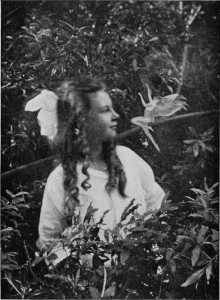Sir Arthur Conan Doyle and The Case of The Cottingley Fairies
Happy Valentines Day dear readers. Here is a beautiful piece from The Public Domain Review…
In the spring of 1920, at the beginning of a growing fascination with spiritualism brought on by the death of his son and brother in WWI, Arthur Conan Doyle took up the case of the Cottingley Fairies. Mary Losure explores how the creator of Sherlock Holmes became convinced that the ‘fairy photographs’ taken by two girls from Yorkshire were real.
“In the winter of 1920, readers of the popular British magazine the Strand found a curious headline on the cover of their Christmas issues. “FAIRIES PHOTOGRAPHED,” it said. “AN EPOCH-MAKING EVENT DESCRIBED BY A. CONAN DOYLE.” The Strand’s readership was well acquainted with Sir Arthur Conan Doyle; most of his wildly popular Sherlock Holmes stories had appeared for the first time in its pages. The great man’s claim that fairies –real fairies – had been photographed in the north of England by two young girls was greeted with wonder, but unfortunately for Conan Doyle, most of it was of the “what can he be thinking?” variety. How could the creator of the world’s most famous, least-fool-able detective have convinced himself that “fairy” photographs were real? Let us proceed, Holmes-like, to examine the question.
Mistake Number One: Misinterpreting the Evidence
To his credit, Conan Doyle made what was (to him) a thorough, scientific, step- by- step investigation of the “fairy” photographs. For his first step, he consulted experts at the London offices of the George Eastman Kodak Company. They examined prints of the first two “fairy” photos and told Conan Doyle they could find no evidence of photo-doctoring; still, they insisted someone who knew enough about photography could have faked them. In Conan Doyle’s mind, that ruled out the two Yorkshire village girls who had taken the photographs, Elsie Wright and Frances Griffiths…”
For the rest, and more photographs, click here.
Share

